 |
August 2016
|
August 2016 // Volume 54 // Number 4 // Feature // v54-4a3
Accommodating Extension Clients Who Face Language, Vision, or Hearing Challenges
Abstract
A survey-based study explored approaches used by one land-grant university to meet the needs of Extension clients who face language, vision, or hearing challenges. In attempts to serve such clients, the greatest gaps existed for clients whose main language was Spanish, followed by those who had vision impairments and then those who had hearing difficulties. Extension professionals surveyed recommended that use of resources to meet the needs of such clients be prioritized as follows: accommodating clients who face language challenges (those whose main language is Spanish), using contractors to adapt materials or provide live assistance, and providing applicable technology or equipment.
Introduction
Providing equal access—for all—to university resources is a national trend. The Commission on Access, Diversity, and Excellence, a standing commission of the Association of Public and Land-Grant Universities (APLU), has a goal of promoting access, not as an option for public land-grant universities, but as a requirement for all member institutions to broaden the path of access and opportunity (APLU, n.d.). Oregon State University (OSU), a member of APLU, highly values the priorities set forth by this commission (Oregon State University, 2012). In 2011, OSU's president asked each college and unit to reevaluate how university resources are provided to students and the public, including Extension clients.
Because land-grant universities across the country have been called on to improve access for all, it is important to understand how Extension attempts to meet this goal. In 2012, Peterson et al. documented how Extension had been serving people during the preceding 12 years. By conducting a literature review of articles published in the Journal of Extension from 2000 to 2012, they found that Extension values diversity and serves individuals who have a variety of disabilities (Peterson et al., 2012). They also established that attracting and providing educational services to marginalized populations, such as individuals with disabilities, adds public value to Extension as an agency (Peterson et al., 2012).
A West Virginia study corroborated these findings by documenting needs for and barriers to providing access to Extension to everyone in the state. In their study of 82 4-H Extension professionals, Boone, Boone, Reed, Woloshuk, and Gartin (2006) found that more than 60% of study participants thought their counties had youth with special needs, including youth with autism, Down syndrome, hearing and visual impairments, and physical and mental disabilities. When asked to indicate conditions they were comfortable accommodating, only 41% of these Extension professionals indicated a willingness to work with youth who have hearing impairments, and only 36% were willing to work with youth who have visual impairments (Boone et al., 2006). Though Extension nationwide has been called on to serve the needs of all, Extension professionals struggle to do so for a variety of reasons.
Previous articles have documented barriers to and gaps in providing access for all. The focus of this article is on documenting how Extension professionals in one state have accommodated clients who face language, vision, or hearing (LVH) challenges while acknowledging that gaps remain. (A companion article in this issue of the Journal of Extension, "Strategies for Accommodating Extension Clients Who Face Language, Vision, or Hearing Challenges," explores accommodation as a tool of the trade for Extension professionals.)
Approaches
The purpose of the study reported here was to develop an understanding of the prevalence of Extension clients who face LVH challenges and the strategies used to serve them. In 2012, OSU Extension faculty and staff were asked to share applicable information relative to programmatic activities they had completed from 2010 to 2012. OSU Extension state and field staff (faculty, program assistants, and research assistants; N = 456) who had taught, delivered programming, hosted conferences for the public, or conducted Extension research were invited to provide feedback through an online survey tool. In line with needs assessment recommendations by Altschuld and Kumar (2010), the following questions were used to guide the research:
- How prevalent are clients who face LVH challenges?
- What are the gaps between actual levels of program participation by these clients and desired levels of program participation by these clients?
- At what rate is Extension directly providing these clients with assistance, and at what rate are these clients helping themselves?
- At what rate should Extension be directly providing these clients with assistance?
- What are the consequences of Extension's not directly providing these clients with assistance?
- What strategies and resources do Extension professionals use to make programming accessible to these clients?
- How do Extension professionals think available resources should be used to make programming accessible to more of these clients?
The survey tool contained 42 questions divided into three sections to address each type of challenge: language, vision, and hearing. Skip patterns were used throughout the survey so that respondents did not have to answer nonapplicable questions. For analysis, the midpoint of each range was used. Following Dillman (2000), we used a multiple-contact strategy to overcome the potential for a low response rate. Extension administration sent the first request, which included a link to the survey and an explanation of the survey's purpose (Urbanowitz & Wilcox, 2013). Weekly reminders were sent over the following 18 days.
Results
Extension professionals from all five OSU Extension program areas—sea grant (SG), 4-H, family and community health (FCH), forestry and natural resources (FNR), and agriculture and natural resources (ANR)—responded to the survey (n = 196), for an overall response rate of 43%. Formal assessments of nonresponse bias were not conducted, but we did not expect that nonrespondents would have had systematically different experiences than respondents had had with clients who face LVH challenges; therefore, we do not believe the data reported here suffer from significant levels of nonresponse bias. However, the data reported here should not be interpreted as generalizable to a population larger than our sample.
Prevalence
Fifty-one percent of respondents reported encountering clients facing language challenges within the 3-year period, at an average of 148 clients per person. Spanish was most often cited as the language spoken by clients facing language challenges, and language barriers occurred most often in the ANR program area, followed by the 4-H program area and then the FCH program area. Forty-four percent of respondents reported having clients with hearing impairments, at an average of 21 clients per person, and 31% of respondents reported having clients with vision impairments, at an average of 34 clients per person.
Approximately 15% of clients facing language challenges did not have access to either their own means or Extension-provided means for overcoming the language barrier to participate in programming (Figure 1). Likewise, roughly 11% of clients with vision impairments did not have access to their own means or Extension-provided means for participating in programming (Figure 1). In contrast, close to 100% of clients with hearing impairments used their own means or Extension-provided means to participate in programming (Figure 1). (The value of greater than 100% shown in Figure 1 is a function of the measurement and estimation method [i.e., relying on the midpoint of response categories], but it suggests that close to 100% of clients with hearing impairments were able to participate in programming.) These data suggest that gaps exist in serving clients who face language and vision challenges, as some clients who face these challenges are going without assistance (Angima, Etuk, & Maddy, 2016).
Figure 1.
Accommodations Made by Extension Professionals for Clients Facing Language, Vision, or Hearing Challenges (n = 189)
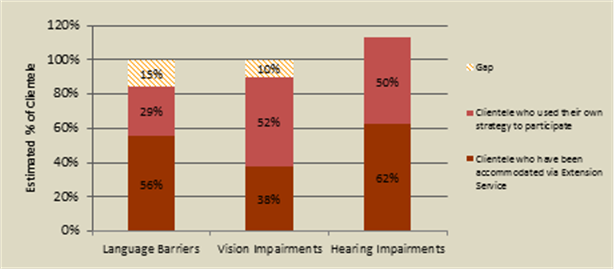
Figure 1 also indicates that the Extension professionals thought they were providing assistance to greater proportions of clients facing language or hearing challenges than clients with vision impairments. Conversely, respondents believed that a greater proportion of clients with vision impairments were using their own means to participate in Extension programming or access Extension materials, as compared to clients facing language or hearing challenges.
We did not gather data about the extent to which clients' own strategies for overcoming LVH challenges were appropriate or adequate. It is possible that the gap between an existing level of accommodation and 100% accommodation is the difference between the percentage of clients who received assistance directly from Extension and the 100% marker rather than the difference between the percentage of clients who either received Extension assistance or used their own strategies and the 100% marker. If this is the case, the actual gaps in serving clients who face LVH challenges could be larger than the results discussed here suggest.
Consequences
All survey respondents who indicated that they had had some interaction with clients facing any of the three challenges were asked what happened when they were unable to provide these individuals with any direct assistance. Respondents were given multiple-choice options and encouraged to check all that applied. The most common responses were that the client did not participate in the programming and that the client or others complained to Extension office staff/faculty or other community leaders about the lack of assistance provided.
Twenty-six percent of respondents reported that when they were unable to accommodate clients facing language challenges, these individuals did not participate in the programming. Eleven percent of respondents reported that clients with vision impairments who could not be accommodated did not participate in the programming. And despite the high percentage of clients with hearing impairments who had access to either their own assistive means or Extension-provided assistance, 12% of respondents reported that clients with hearing impairments did not participate in programming as a result of not having hearing-related assistance.
Strategies and Resources Used
Extension professionals used different strategies and an array of resources to provide assistance to clients facing LVH challenges. To address clients facing language challenges (Figure 2), most respondents (84%) used translated materials, and just over half (52%) used language translators. Translation of written materials was more common than spoken translation.
Figure 2.
Strategies Used by Extension Professionals Who Provided Language Assistance to Clients (n = 77)
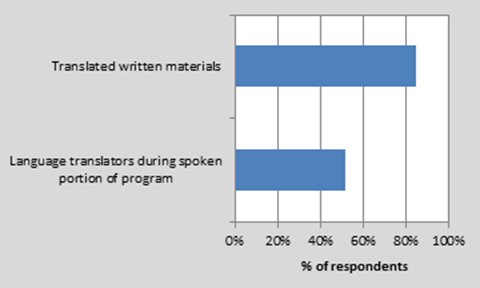
Largely, Extension professionals used their own time and local partners to translate written materials or translate aloud. Figure 3 shows that about half of the respondents reported relying on a community partner to adapt materials for clients facing language challenges. Just under half of the respondents reported using their own time to adapt materials. Using equipment and/or funds for language accommodation available within their offices was less common, but such resources were used by about a quarter of the respondents. Only about 20% of respondents reported using external contractors for language translation, and fewer than 10% reported using state Extension resources or the university's Office of Equity and Inclusion.
Figure 3.
Resources Used by Extension Professionals Who Provided Language Assistance to Clients (n = 77)
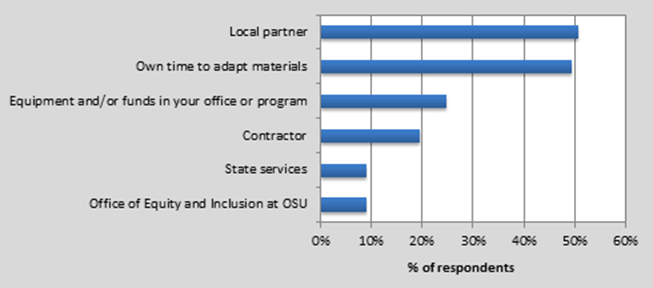
Extension professionals used several strategies to provide assistance to clients with vision impairments (Figure 4). The most common strategy was providing written materials having large-font text (74%), followed distantly by assigning people to help individuals with visual impairments (26%).
Figure 4.
Strategies Used by Extension Professionals Who Provided Vision Assistance to Clients (n = 34)

In terms of resources used to help clients with vision impairments (Figure 5), most respondents (63%) reported using their own time to adapt materials, but a sizable minority (26%) reported using equipment and/or funds from local offices. Local partners, state services, and assistance from the university's Office of Equity and Inclusion were not very commonly used, and no respondents reported using contractors.
Figure 5.
Resources Used by Extension Professionals Who Provided Vision Assistance to Clients (n = 34)

In contrast to strategies used to provide language assistance, Extension professionals who accommodated clients with hearing impairments tended to rely more on live interpretation than on written translation (Figure 6). About one-third of respondents used American Sign Language interpreters during Extension programming, and 21% of respondents converted audio materials to text. Forty-six percent of respondents reported using various other strategies, such as seating clients who were hard of hearing close to the front of the room or near speakers, using microphones for presenters, and increasing the volume for any audio elements used in a program.
Figure 6.
Strategies Used by Extension Professionals Who Provided Hearing Assistance to Clients (n = 39)
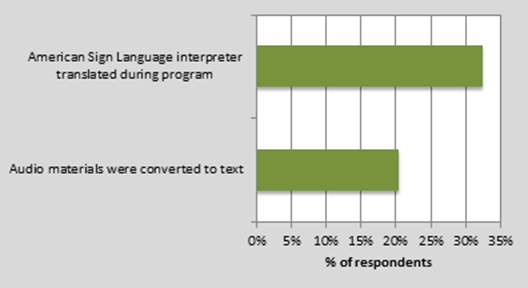
Extension professionals used various resources to provide assistance to clients with hearing impairments (Figure 7). As with resource use for language and vision accommodations, many respondents (51%) reported using their own time to adapt materials. Twenty-one percent used equipment and/or funds from their local offices. In contrast to the results for the other types of challenges, however, a notable percentage of respondents who provided assistance to clients with hearing difficulties relied on resources from the university's Office of Equity and Inclusion (18%). It was not very common for respondents to use contractors, local partners, or state Extension resources.
Figure 7.
Resources Used by Extension Professionals Who Provided Hearing Assistance to Clients (n = 39)

Overall, the data showed that the Extension professionals were more likely to rely on local partners and their own time as resources for accommodating clients facing language challenges, and they most often used their own time and local office resources to adapt materials to accommodate clients facing vision and hearing challenges. These findings suggest that convenience is a factor in making decisions about accommodations. Using nearby resources (oneself and resources available in one's office) was generally more popular than using resources from the community or campus, perhaps because there is a time delay in accessing or using those more distant resources.
No overall trend was apparent for types of accommodation strategies. Respondents used different strategies for each type of challenge. Perhaps Extension professionals are using the strategies they perceive to be most efficient.
Recommendations by Extension Professionals
Extension professionals were asked to recommend ways Extension should spend finite resources to collectively address LVH challenges. Figure 8 summarizes those recommendations and includes recommendation themes supported by more than 5% of respondents.
Figure 8.
Extension Professionals' Recommendations for How Central Extension Administration Should Spend Finite Resources to Address Clients' Language, Vision, and Hearing Challenges (n = 196)
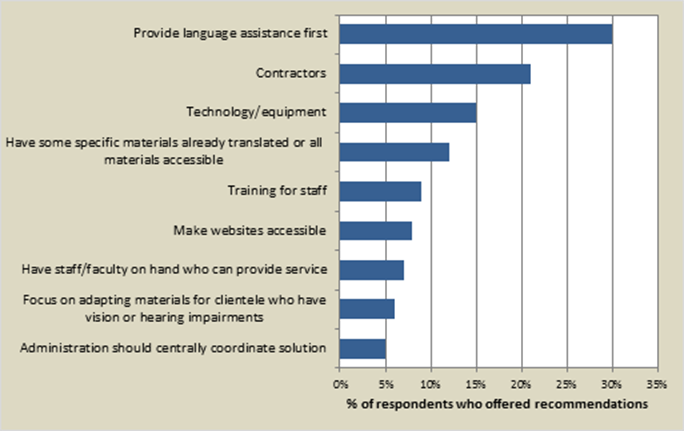
The top three recommendations (in order) for how to spend Extension resources to address LVH challenges were as follows: accommodate clients who face language challenges (i.e., clients whose main language is Spanish), use contractors to adapt materials or provide live assistance, and make applicable technology or equipment available. The Spanish language service needs were more prevalent in the FCH, ANR, 4-H, and SG program areas (in that order). Extension administration's centrally coordinating of services to accommodate clients with hearing impairments was more commonly suggested by respondents in the ANR and FNR program areas. These findings are reflective of the different types of clients served by personnel working in each program area.
Conclusion
Serving clients who face LVH challenges is a priority for Extension services nationwide. As the population ages and becomes increasingly diverse, the need for resources and programming to accommodate individuals with vision or hearing impairments or limited English proficiency will continue to grow. This priority is clear, but we know little about the ways Extension professionals accommodate these populations. This case study provides initial insights for how Extension professionals in one state accommodate clients who face LVH challenges.
Although our study results indicate that the majority of clients who face LVH challenges were managing to participate in Extension programming or access materials, survey respondents believed that some were being missed. Depending on the standard applied (full participation or provision of assistance by Extension to all clients facing a challenge), between 11% and 60% of clients facing a particular type of challenge are going without assistance across Extension programming. A notable proportion of respondents believed that the consequence was limited participation in Extension programming. This is a serious implication, and it suggests that finding ways to help clients who face these challenges should be a priority.
In addition, we in Extension need to decide how we want clients who face LVH challenges to participate and be accommodated in our programming. Is it appropriate to expect some clients to address their own needs without Extension's providing assistance and still meet federal requirements? Can such a scenario count as "all reasonable effort" on the part of Extension as a whole? What should our goals be? And how do we communicate those goals and provide the support we determine to be appropriate and required?
The study described here also revealed that the Extension professionals who responded used a variety of strategies and resources to accommodate clients facing LVH challenges. These professionals tended to use resources that were close at hand and fairly easy to access and deploy. Interestingly, the exception was for assistance to clients facing language barriers; a high percentage of Extension professionals relied on local community partners to help with translation. Coupled with the finding that respondents believed they were providing direct assistance to the greatest proportion of clients facing challenges, this circumstance may imply that providing assistance will require using strategies that rely on resources not necessarily close at hand for faculty and staff.
The case study reported here is a first step. Further studies in other states may indicate whether similar patterns of accommodation and access exist for Extension clients who face LVH challenges.
References
Altschuld, J. W., & Kumar, D. D. (2010). The needs assessment KIT—Book 1, needs assessment: An overview. Thousand Oaks, CA: Sage.
Angima, S., Etuk, L., & Maddy, D. (2016). Strategies for accommodating Extension clients who face language, vision, or hearing challenges. Journal of Extension [online], 54(4) Article 4TOT2. Available at: http://www.joe.org/joe/2016august/tt2.php
Association of Public and Land-Grant Universities. (n.d.). Access, diversity and excellence. Retrieved from: http://www.aplu.org/members/commissions/access-diversity-and-excellence/
Boone, D. A., Boone, H. N., Jr., Reed, C., Woloshuk, J. M., & Gartin, S. A. (2006). Attitudes of Extension professionals toward involvement of special needs youth in 4-H programs. Journal of Extension [online], 44(6) Article 6FEA4. Available at: http://www.joe.org/joe/2006december/a4.php
Dillman, D. A. (2000). Mail and Internet surveys: The tailored design method (2nd ed.). Hoboken, NJ: John Wiley and Sons.
Oregon State University. (2012). Accessibility. Retrieved from http://oregonstate.edu/accessibility/memos
Peterson, L. R., Grenwelge, C., Benz, R. M., Zhang, D., Resch, A. J., Mireles, G., & Mahadevan, L. (2012). Serving clientele with disabilities: An assessment of Texas FCS agents' needs for implementing inclusive programs. Journal of Extension [online], 50(6) Article 6FEA7. Available at: http://www.joe.org/joe/2012december/a7.php
Urbanowitz, S. C., & Wilcox M. D., Jr. (2013) Examining Extension's capacity in community resource and economic development: Viewpoints of Extension administrators on the role of community resource and economic development in the Extension portfolio. Journal of Extension [online], 51(5) Article 5FEA2. Available at: http://www.joe.org/joe/2013october/a2.php




